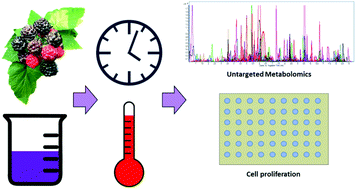Storage conditions modulate the metabolomic profile of a black raspberry nectar with minimal impact on bioactivity
Abstract
Pre-clinical and clinical studies suggest black raspberries (BRBs) may inhibit the development of oral cancer. Lyophilized BRB powder is commonly used in these studies, but processed BRB products are more often consumed. The objective of this work was to understand how storage conditions influence the phytochemical profile and anti-proliferative activity of a BRB nectar beverage. Untargeted UHPLC-Q-TOF-MS based metabolomics analyses demonstrated that large chemical variation was introduced by storage above −20 °C over 60 days. However, minimal change in anti-proliferative activity was observed when stored nectar extracts were applied to SCC-83-01-82 premalignant oral epithelial cells. As proof of concept, cyanidin-3-O-rutinoside and its degradation product, protocatechuic acid, were administered in different ratios maintaining an equimolar dose, and anti-proliferative activity was maintained. This study shows the utility of metabolomics to profile global chemical changes in foods, while demonstrating that isolated phytochemicals do not explain the complete bioactivity of a complex food product.



 Please wait while we load your content...
Please wait while we load your content...